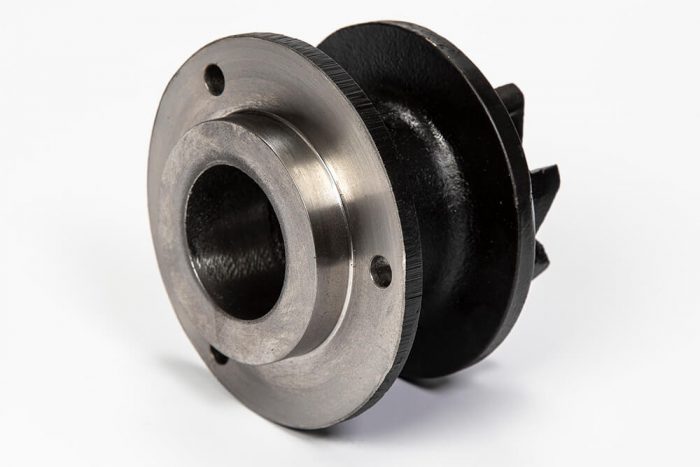Spheroidal graphite iron castings, also known as ductile iron, are a type of cast iron that has become increasingly popular in recent years due to their unique properties. This type of iron is created by adding magnesium to molten iron, which results in the formation of graphite nodules that give the iron its characteristic spheroidal shape. These graphite nodules provide a number of benefits over other types of cast iron, including increased ductility, toughness, and resistance to fracture.
Spheroidal graphite iron castings are used in a wide variety of applications, including automotive, aerospace, and construction industries. They are particularly useful in applications where high strength and durability are required, such as in the manufacture of engine blocks, gears, and other heavy-duty machinery. In addition, spheroidal graphite iron castings are also used in the production of pipes, valves, and other components that require resistance to corrosion and wear.
Overall, spheroidal graphite iron castings are a versatile and reliable material that has become increasingly popular in a wide range of industries. Their unique properties make them an excellent choice for a variety of applications, and their widespread use is a testament to their durability and effectiveness.
Overview of Spheroidal Graphite Iron Castings
Spheroidal graphite iron castings, also known as ductile iron castings, are a type of cast iron with graphite nodules or spheroids. These spheroids give the material its unique mechanical properties, including high ductility, tensile strength, and wear resistance.
Definition and Composition
Spheroidal graphite iron castings are made up of a matrix of ferrite and pearlite, with graphite nodules dispersed throughout. The graphite nodules are formed during the manufacturing process, which involves adding magnesium to the molten iron. The magnesium reacts with the carbon in the iron, causing it to form nodules instead of flakes.
The composition of spheroidal graphite iron castings can vary depending on the specific application. Generally, they contain between 3.2% and 4.1% carbon, 1.8% to 2.8% silicon, and small amounts of other elements such as manganese, phosphorus, and sulfur.
Manufacturing Process
The manufacturing process for spheroidal graphite iron castings involves several steps. First, the raw materials are melted in a furnace. Once the molten iron has reached the desired temperature, magnesium is added to the mix. The amount of magnesium added depends on the desired size and shape of the graphite nodules.
After the magnesium has been added, the molten iron is poured into a mold. The mold is usually made of sand, and is designed to create the desired shape of the casting. Once the molten iron has cooled and solidified, the mold is removed, and the casting is cleaned and finished.
Spheroidal graphite iron castings are used in a wide variety of applications, including automotive parts, machinery components, and pipes. They are known for their strength, durability, and resistance to wear and corrosion.
In conclusion, spheroidal graphite iron castings are a type of cast iron with unique mechanical properties due to the presence of graphite nodules. The manufacturing process involves adding magnesium to the molten iron, which causes the graphite to form nodules instead of flakes. These castings are widely used in various industries due to their strength and durability.
Properties of Spheroidal Graphite Iron Castings
Spheroidal graphite iron castings, also known as ductile iron castings, are a type of cast iron with a unique microstructure that provides excellent mechanical properties, chemical resistance, and machinability. This section will explore the properties of spheroidal graphite iron castings, including their mechanical properties, chemical properties, and microstructure.
Mechanical Properties
Spheroidal graphite iron castings have excellent mechanical properties, including high tensile strength, yield strength, elongation, and ductility. The ultimate tensile strength of spheroidal graphite iron castings ranges from 400 to 800 MPa, while the proof stress ranges from 250 to 500 MPa. The elongation of spheroidal graphite iron castings is typically between 15% and 25%, and the fracture toughness is between 50 and 100 MPa m1/2.
Chemical Properties
Spheroidal graphite iron castings have excellent chemical resistance, making them suitable for use in harsh environments. They are resistant to corrosion, oxidation, and erosion, and can withstand exposure to chemicals, acids, and alkalis. The chemical composition of spheroidal graphite iron castings typically includes carbon, silicon, manganese, sulfur, and phosphorus, with trace amounts of other elements.
Microstructure
The microstructure of spheroidal graphite iron castings is unique, with nodules of graphite distributed throughout the matrix of ferrite and pearlite. The nodules of graphite provide excellent machinability, while the matrix of ferrite and pearlite provides excellent strength and toughness. The nodularity of spheroidal graphite iron castings typically ranges from 70% to 90%, and the hardness ranges from 150 to 250 HB.
In conclusion, spheroidal graphite iron castings have excellent mechanical properties, chemical properties, and microstructure, making them ideal for use in a wide range of applications. Whether you need a material that can withstand harsh environments or one that provides excellent machinability, spheroidal graphite iron castings are an excellent choice.
Advantages of Spheroidal Graphite Iron Castings
Spheroidal Graphite Iron (SGI) castings have become increasingly popular in various industries due to their unique properties. This section will discuss the advantages of SGI castings compared to other materials and their applications.
Compared to Other Materials
Compared to steel castings, SGI castings have a higher tensile strength, yield strength, and ductility. They also have better wear resistance and fatigue strength. In addition, SGI castings are easier to machine and have better vibration damping properties.
Compared to gray cast iron, SGI castings have a higher tensile strength, yield strength, and elongation. They also have better ductility and impact resistance. Furthermore, SGI castings have a better fatigue strength and are more resistant to thermal shock.
Compared to nodular cast iron (ductile cast iron), SGI castings have a higher tensile strength, yield strength, and elongation. They also have better impact resistance and fatigue strength. In addition, SGI castings have a better wear resistance and are more resistant to thermal shock.
Applications
SGI castings are widely used in various industries, including automotive, agriculture, construction, and mining. They are used to manufacture components such as gears, crankshafts, camshafts, brake components, and suspension parts.
In the automotive industry, SGI castings are used to manufacture engine blocks, cylinder heads, and transmission cases. They are also used to manufacture steering knuckles, brake calipers, and suspension components.
In the agriculture industry, SGI castings are used to manufacture components such as plowshares, cultivator teeth, and harrow discs. They are also used to manufacture components for irrigation systems.
In the construction industry, SGI castings are used to manufacture components such as manhole covers, gratings, and drainage systems. They are also used to manufacture components for heavy equipment such as excavators and bulldozers.
In the mining industry, SGI castings are used to manufacture components such as crusher liners, wear plates, and grinding balls. They are also used to manufacture components for drilling equipment.
Overall, SGI castings offer a range of advantages over other materials, making them a popular choice in various industries.
Disadvantages of Spheroidal Graphite Iron Castings
Spheroidal graphite iron castings have many advantages over other types of cast iron, but they also have some disadvantages that should be considered before selecting them for a specific application. This section will discuss two main disadvantages of spheroidal graphite iron castings: brittle failure and cracking.
Brittle Failure
Spheroidal graphite iron castings can experience brittle failure if they are exposed to high levels of oxygen during the casting process. This is because oxygen can cause the graphite in the iron to form into flakes rather than spheres, which weakens the material and makes it more prone to sudden fracture. To prevent this, the casting process must be carefully controlled to minimize oxygen exposure.
Cracking
Another disadvantage of spheroidal graphite iron castings is that they can be prone to cracking if they are not properly heat-treated after casting. This is because the material can experience residual stress as it cools, which can cause cracks to form. To prevent this, the castings must be carefully heat-treated to relieve the stress and ensure that they are strong and durable.
In summary, while spheroidal graphite iron castings have many advantages, they can also experience brittle failure and cracking if they are not carefully cast and heat-treated. These disadvantages must be considered before selecting this type of casting for a specific application.

Improving Spheroidal Graphite Iron Castings
Spheroidal Graphite Iron (SGI) castings are widely used in various industries due to their unique properties. However, producing SGI castings without structural defects and graphite degenerations such as chunky graphite is a challenging task. Here, we discuss some strategies to improve the quality of SGI castings.
Strategy
The most common strategy to improve the quality of SGI castings is to control the nucleation and growth of graphite nodules during solidification. This can be achieved by using a proper combination of alloying elements, inoculation, and isothermal heat treatment.
As-Cast vs. Heat Treated
As-cast SGI castings have a random arrangement of graphite nodules, which can lead to anisotropic properties. On the other hand, heat-treated SGI castings have a controlled arrangement of graphite nodules, which can improve the mechanical properties. Isothermal heat treatment is the most commonly used heat treatment process for SGI castings.
Additives
Additives such as sulfur, magnesium, cerium, and nickel can be used to improve the quality of SGI castings. Sulfur is used as a nucleating agent, while magnesium is used as an inoculant. Cerium is used to modify the graphite morphology, and nickel is used to improve the mechanical properties.
In conclusion, improving the quality of SGI castings requires a combination of strategies such as controlling the nucleation and growth of graphite nodules, isothermal heat treatment, and the use of proper additives. By implementing these strategies, it is possible to produce defect-free SGI castings with improved mechanical properties.
Conclusion
In conclusion, spheroidal graphite iron castings are becoming increasingly popular due to their exceptional attributes. It is important to note that the formation of chunky graphite can affect the quality of castings, and it is necessary to assess castings affected by chunky graphite.
When selecting a material grade for spheroidal graphite iron castings, it is essential to consider the application and the required properties. The addition of impurities such as cerium or magnesium to the melt before casting can change the graphite shape from lamellar to spheroidal, improving the nodularity of spheroidal graphite.
Wall thicknesses can also affect the nodularity of spheroidal graphite. It is known that the nodularity of spheroidal graphite is sensitive to casting size, i.e. to cooling rate. Therefore, it is important to consider the wall thickness when designing spheroidal graphite iron castings.
Test pieces are used to evaluate the strength of flake and spheroidal graphite cast irons. The presence of graphite in flake graphite cast iron interrupts the continuity and breaks at a lower load when the thickness of the specimen is lower. In contrast, spheroidal-shaped graphite in spheroidal graphite cast iron minimizes its effect in failure. The loading curves for spheroidal graphite cast iron reflect the behavior of brittle material.
In summary, spheroidal graphite iron castings offer a combination of outstanding attributes that make them increasingly attractive to designers. The selection of material grade, consideration of wall thickness, and evaluation of test pieces are all important factors to consider when designing spheroidal graphite iron castings.
